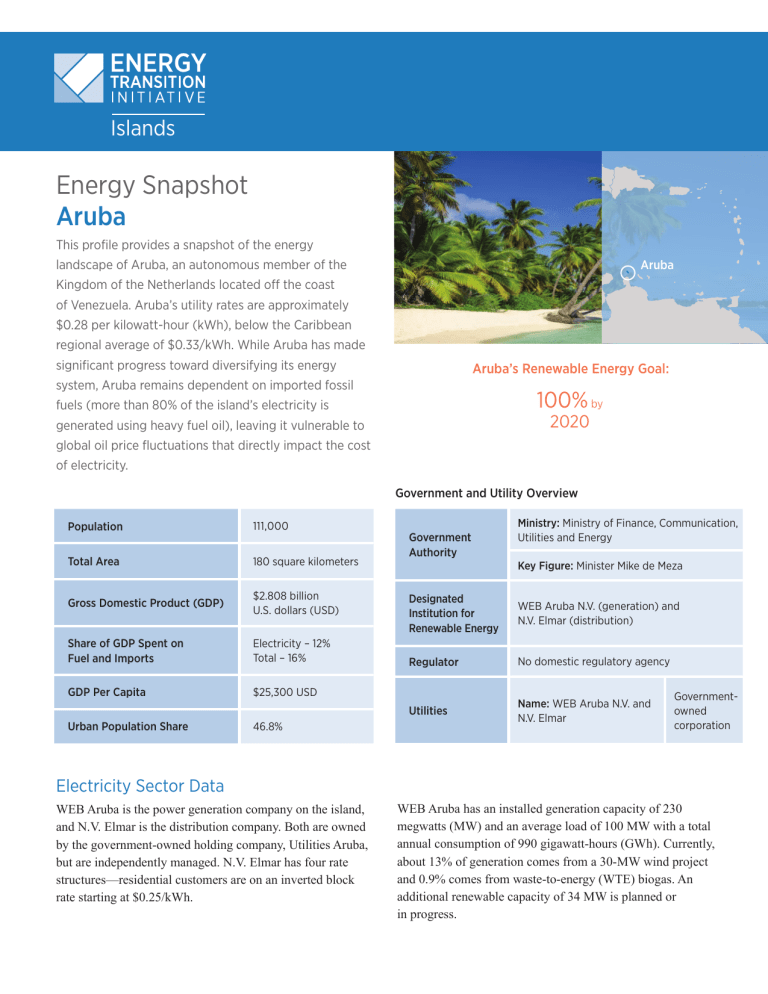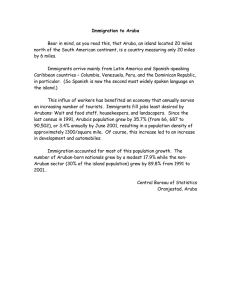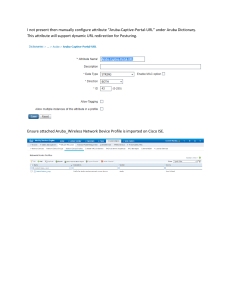
Islands Energy Snapshot Aruba This profile provides a snapshot of the energy landscape of Aruba, an autonomous member of the Aruba Kingdom of the Netherlands located off the coast of Venezuela. Aruba’s utility rates are approximately $0.28 per kilowatt-hour (kWh), below the Caribbean regional average of $0.33/kWh. While Aruba has made significant progress toward diversifying its energy Aruba’s Renewable Energy Goal: system, Aruba remains dependent on imported fossil 100% by fuels (more than 80% of the island’s electricity is 2020 generated using heavy fuel oil), leaving it vulnerable to global oil price fluctuations that directly impact the cost of electricity. Government and Utility Overview Population 111,000 Total Area 180 square kilometers Gross Domestic Product (GDP) $2.808 billion U.S. dollars (USD) Share of GDP Spent on Fuel and Imports Electricity – 12% Total – 16% GDP Per Capita $25,300 USD Urban Population Share 46.8% Government Authority Ministry: Ministry of Finance, Communication, Utilities and Energy Key Figure: Minister Mike de Meza Designated Institution for Renewable Energy WEB Aruba N.V. (generation) and N.V. Elmar (distribution) Regulator No domestic regulatory agency Utilities Name: WEB Aruba N.V. and N.V. Elmar Governmentowned corporation Electricity Sector Data WEB Aruba is the power generation company on the island, and N.V. Elmar is the distribution company. Both are owned by the government-owned holding company, Utilities Aruba, but are independently managed. N.V. Elmar has four rate structures—residential customers are on an inverted block rate starting at $0.25/kWh. WEB Aruba has an installed generation capacity of 230 megwatts (MW) and an average load of 100 MW with a total annual consumption of 990 gigawatt-hours (GWh). Currently, about 13% of generation comes from a 30-MW wind project and 0.9% comes from waste-to-energy (WTE) biogas. An additional renewable capacity of 34 MW is planned or in progress. Electricity Sector Overview Total Installed Capacity Energy Consumption by Sector 230 MW Residential 34% Other 2% Peak Demand 125 MW Commercial, Small 29% Commercial, Large 35% Total Generation 990 GWh Energy Generation Mix Renewable Share 15.4% Biomass 0.9% Solar 1.5% Proposed/Planned Renewable Projects Heavy Fuel Oil 84.6% Wind 13% 34 MW Existing Policy and Regulatory Framework Renewable Energy Clean Energy Policy Environment Feed-in Tariff In a 2011 document titled “The Green Gateway,” the Government of Aruba presented its plan for economic development, which included promoting clean energy. In 2012, during the Rio +20 United Nations Conference on Sustainable Development, the country announced its 100% renewable energy use by 2020 goal. Net Metering/Billing In order to reach that goal, Aruba has undertaken targeted efforts for integrating more renewables. In 2012, N.V. Elmar instituted a revised net metering policy. The new policy increases the maximum capacity to 10 kW for residential customers and 100 kW for other customers, and compensates system owners for surplus production. Tax Reduction/Exemption Lastly, import duties on wind turbines, solar panels, and electric cars and parts were recently reduced to encourage adoption of clean energy technologies. Interconnection Standards Renewables Portfolio Standard/Quota Tax Credits Public Loans/Grants Green Public Procurement Energy Efficiency Energy Efficiency Standards Tax Credits Tax Reduction/Exemption Public Demonstration Restrictions on Incandescent Bulbs Appliance Labeling Standards Targets Renewable Energy Energy Efficiency In Place In Development Renewable Energy Status and Potential Wind Potential: High Installed Capacity: 30 MW Hydropower Potential: Low Installed Capacity: 0 Geothermal Ocean Potential: Low Installed Capacity: 0 Potential: Unknown Installed Capacity: 0 Biomass Potential: Low Installed Capacity: 2 MW Solar Potential: High Installed Capacity: 3.5 MW Energy Efficiency and Renewable Energy Projects Opportunities for Clean Energy Transformation An energy demand reduction program is underway as the government continues to upgrade all public lighting with energy-efficient LED technology. Because 50% of Aruba’s energy demand comes from cooling, the utility installed a pilot ice storage cooling system that makes ice at night when electricity costs are lower. The ice is then used the following day to cool buildings instead of traditional air conditioning. Aruba will depend heavily on variable wind and solar to reach its renewable energy goals. Developing a 100% renewable energy framework requires overbuilding capacity or integrating storage technologies to compensate for the variable nature of wind and solar. Currently, Aruba gets 15.4% of its electricity from renewable sources. The island has sufficient renewable energy resource potential, with excellent technical potential for ocean, wind, and solar renewable energy generation. The island’s 30-MW wind project at Vader Piet produces 13% of Aruba’s load requirements—an additional 26.4 MW of wind is slated to come online in late 2015. WEB Aruba is hoping to add 3 MW to 6 MW to the biogas plant with a goal of using 70% of household waste. A 3.5-MW airport solar project was completed in November 2014, but production data are not yet available. An additional 6 MW of solar capacity is planned for the residential and commercial sectors. WEB Aruba is researching ocean thermal energy conversion, geothermal power, and energy storage technologies. To leverage these resources, however, the island must address barriers, such as limited open land and steeply sloping seabed, to support new projects. Advanced technology, such as floating offshore wind turbines, and novel applications of commercial technology may be needed to reach the ambitious—but achievable—goal of 100% renewable energy for Aruba. Sources The information provided in this fact sheet was developed using the following sources. Carbon War Room, Smart Growth Pathways: Building a Green Platform for Sustainable Aruba: http://carbonwarroom.com/what-we-do/research-publications/ smart-growth-pathways-building-green-platform-sustainable-aruba. Central Intelligence Agency, World Factbook, Aruba: https://www.cia.gov/library/publications/the-world-factbook /geos/aa.html. Energy Transition Initiative This energy snapshot was prepared to support the Energy Transition Initiative, which leverages the experiences of islands, states, and cities that have established a long-term vision for energy transformation and are successfully implementing energy efficiency and renewable energy projects to achieve established clean energy goals. Through the initiative, the U.S. Department of Energy and its partners provide government entities and other stakeholders with a proven framework, objective guidance, and technical tools and resources for transitioning to a clean energy system/economy that relies on local resources to substantially reduce reliance on fossil fuels. Climate Innovation Center Caribbean, Aruba’s First Waste to Energy Project: http://caribbeancic.org/climate-technology/ aruba%E2%80%99s-first-waste-energy-project. Columbia University, State of the Planet, Aruba’s Sustainability Agenda: http://blogs.ei.columbia.edu/2014/04/02/ arubas-sustainability-agenda/. GreenAruba, “Future Plans: Innovation & New Technology,” Presented July 2013: http://www.greenaruba.org/ga4/pdf/ presentations/2013/07%20Francis%20Ras%20-%20Prezi_ Ras_Final.pdf. Ministry of Economic Affairs, Social Affairs and Culture, The Green Gateway: A Knowledge-Driven, Entrepreneurial Economy— Economic Vision and Policy: http://www.arubaeconomicaffairs.aw/ TheGreenGateway.pdf. Renewable Energy World.com, “Brink: Aruba’s Bright Solar Vision, Clouded Bureaucracy:” http://www.renewableenergyworld.com/rea/blog/post/2013/09/ brink-arubas-bright-solar-vision-clouded-bureaucracy. The Report Company, Embracing the Winds of Change: http://www.the-report.net/aruba/ utilities-jun2014/950-aruba-embracing-wind-energy-potential. Utilities Aruba, Aruba’s Sustainable Future: http://www.utilitiesarubanv.com/main/wp-content/uploads/2014/08/ Utilities-Aruba-Corporate-Report-June-2014-by-The-ReportCompany.pdf. WEB Aruba: http://www.webaruba.com Page 1 photo from Shutterstock 225254236; page 4 photo from iStock 29878236 Prepared by the National Renewable Energy Laboratory (NREL), a national laboratory of the U.S. Department of Energy, Office of Energy Efficiency and Renewable Energy; NREL is operated by the Alliance for Sustainable Energy, LLC. Islands DOE/GO-102015-4584 • March 2015




